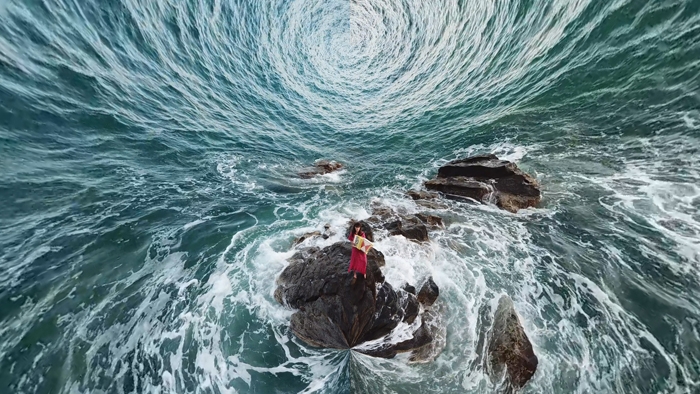Editor’s note: this article was first published as part of the 2017 Future Greats issue and is being republished here to coincide with the opening of Raphaela Vogel: Vogelspinne at BQ Gallery on Friday 26 April, as part of Gallery Weekend Berlin
In Raphaela Vogel’s works, technology (in the form of scanners, action cameras and drones) is not simply a means to an end, but an active protagonist. Her short performance-based films feature pulsing footage of various environments (manipulated by advanced editing techniques and often accompanied by powerful – including heavy-metal – soundtracks), which is then projected onto installations made of metal rods, ropes, foils and various readymade objects. In most of the works, Vogel herself is also insistently present, the alluring heroine of film installations such as mogst mi du ned, mog i di (2015), a work that takes matters a step further to negotiate the relationship between body, space and technology. Employing the most contemporary devices, such as drones equipped with minicameras, Vogel entangles the viewer in a perverse, voyeuristic story that deploys notions of surveillance, control and physical trespass.
Vogel entangles the viewer in a perverse, voyeuristic story that deploys notions of surveillance, control and physical trespass
Vogel herself is an insistently present, feminine and, to a certain extent, exhibitionistic persona. In some of her sculptural environments, painted animal hides resemble reliclike objects (for example Raphaela, 2015), or constructions with urinals and shisha-pipes (She Shah, 2016) suggest, and at the same time appropriate, the typical decor of the private clubs in which men gather to conduct rituals channelling their baser instincts. Here, though, any suggestions of a power relationship that might have sadistic or masochistic undertones is steered more towards a zone of contact that resembles a trap. She subverts the active, masculine ‘fetishistic gaze’, often supported by technology, and commonly giving men the power to control and halt the action, by directing that technology herself. In doing so she sets up a site in which far more complex and asymmetrical power dynamics are articulated. The installations, or ‘video-sculptures’, as the artist calls them, reveal their machinery while simultaneously evincing a fascination with it, which in turn exploits our very familiarity with the dynamics of the contemporary ‘experience industry’ in order to generate a relational engagement from viewers. Ultimately, the work relies on our role as a fetishistic spectator who is simultaneously aware of the fiction and of the technique – knowing our pleasure resides in the experience of both. In the past, Vogel’s miniformat cameras have not only been fixed to drones but also to horse limbs – as if combined into some sort of hybrid modern-primitivist device that exposes the primal elements that lie hidden within the shell of contemporaneity. By alternating imagery from the physical environment with projected images of a lake, a tongue or a Carrara stone quarry, she blurs the lines between the familiar and the abandoned and the new promise of technology.
Vogel is based in Amsterdam. She has a solo exhibition, She Shah, at Westfälischer Kunstverein, Münster, through 12 February. She is represented by BQ, Berlin.
From the January & February 2017 issue of ArtReview, in association with K11 Art Foundation
